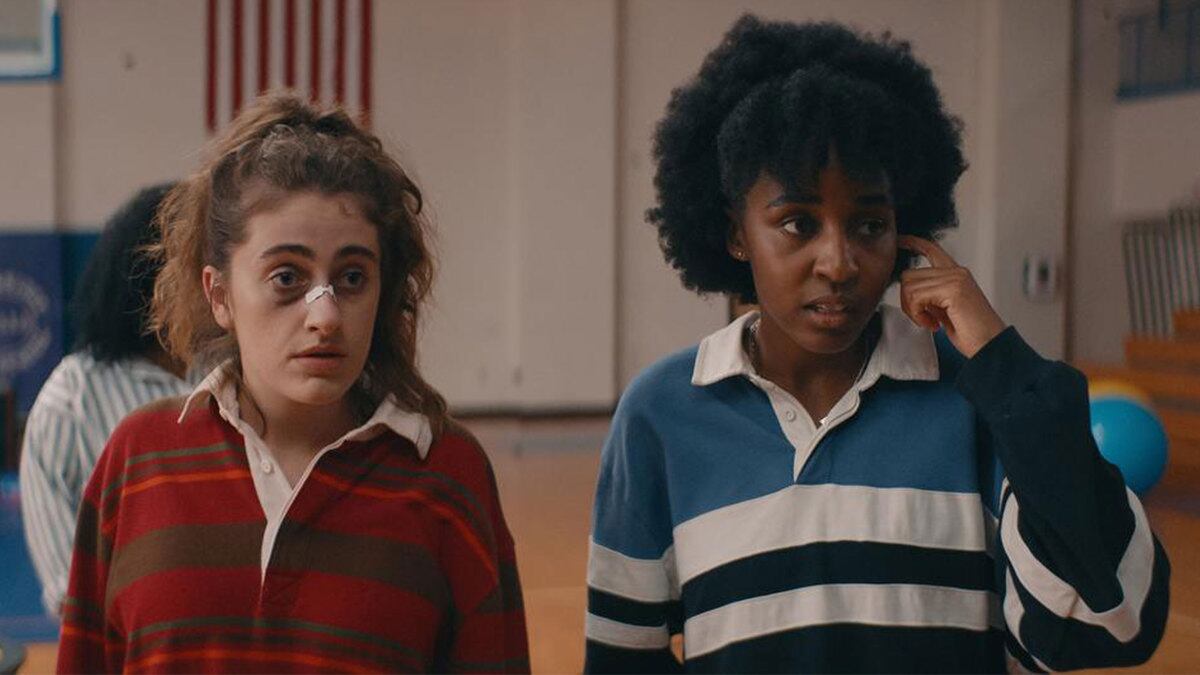I thought I knew what high school movies were. And I thought I knew what they could be. But nothing in my storied history of clamoring for cinema’s supreme dreams of teen queens could have prepared me for Bottoms.
Audiences at SXSW were warned prior to the film’s start that it wouldn’t be what they expected. The fired-up, late-night crowd had wrapped around city blocks and across intersections, quite literally vibrating with anticipation for one of the festival’s most buzzworthy films—and for good reason! Its stars, Ayo Edebiri and Rachel Sennott, have proven themselves massive players in the indie comedy scene with only a handful of big projects under their respective belts. And the film’s director, Emma Seligman, racked up critical praise in 2020 for her directorial debut, Shiva Baby, also starring Sennott.
Whether the audience were fans of Edebiri and Sennott’s Comedy Central web series, Ayo and Rachel Are Single, or just had the best claustrophobic episode of their lives watching Shiva Baby didn’t matter. Preconceived notions are thrown out the window shortly into Seligman’s sophomore feature, which only becomes more delightfully peculiar with each passing second. Bottoms harnesses the unique strengths of all three of its main players—Sennott, Edebiri, and their director, Seligman—and puts them on a volatile, highly hormonal collision course of gonzo teen comedy, unlike anything that has ever been seen in the genre.
Adolescence is nothing if not fraught with constant frustration, which is exactly what PJ (Sennott) and Josie (Edebiri) are feeling as they get ready for their high school’s fall carnival. The girls, who are both gay, are lamenting their perennial loser status. It doesn’t help that Josie is now sporting a shoulder sling after a minor injury, knocking her even further down the popularity totem pole. Unlike a conventional high-school story, the pair aren’t outcasts because they’re queer, but because they’re simply untalented and uninteresting.
But that can all change! Loserdom is not a state of permanence, or so the girls quickly learn when an accident at the carnival results in one of their high school’s star football players being seriously injured. That is, if you’d equate a freak disaster with Josie tapping his knee with all the strength of a pediatrician’s rubber, reflex-testing hammer. This incident incites a panic among their school’s team of uber-popular football players and cheerleaders, welcoming the first of Bottoms’ neverending oddities.
Until this moment, Bottoms feels like a raunchy, R-rated version of your average teen comedy, complete with older stars at the helm. Think Do Revenge meets Pen15, but played totally straight. But when that layer of normalcy is peeled off, Bottoms begins to tilt hard into its own strangeness. Josie’s graze of a quarterback’s knee with her car’s bumper is treated with the gravity of Pearl Harbor. Rumors begin to fly, and Josie makes up a lie about her shoulder sling being the result of a summer spent in juvie. Using their newfound standing as the subjects of the rumor mill to attract their cheerleader crushes, PJ and Josie start an extracurricular self-defense club for fellow girls in their class who want to learn how to shiv a rival.
The inception of their club is where Bottoms finds its footing after a shaky start, letting itself be unabashedly bizarre now that it’s shed the guise of luring in viewers with genre conventions. Kernels of eccentricity are dropped with all of the subtlety of nuclear bombs. There are juiced-up, weight-lifting high school students kept in cages in the background, and a class on feminism being taught by former NFL superstar Marshawn Lynch. Needle drops of iconic songs land in all of the right spots, ricocheting back and forth from earnestness to irony at breakneck pace. At times, it’s a genuine marvel how the film manages to craft a coherent and uproarious storyline while being so plainly—and gleefully—moronic.
Bottoms was co-written by Seligman and Sennott, and seeps with both of their distinct styles. Seligman has a knack for heightening the absurdity of everyday situations. Sennott, on the other hand, is fantastic at spinning even the most mundane of punchlines with an almost oxymoronic mixture of unaffected haughtiness and total sincerity. Together, the two create a vibrant energy that glows throughout the film. Their screenplay is careful not to be surreal for surreality’s sake, and instead pulses with the kind of confidence that comedies rarely see anymore.
Which is not to say that the film won’t see its fair share of detractors. I’m sure Twitter vultures are already cracking their knuckles and strapping on their wrist braces in anticipation of doing their damndest to call out the film’s jokes about rape and terrorism. A good chunk of the film’s screenplay sounds horrific on paper, but is genuinely funny and considerate within the context of the film. In that respect, Bottoms is prepared for its own slander. It’s teeming with confidence, but its self-assuredness never feels self-important.
Seligman and Sennott earn every single laugh that their screenplay gets, while Edebiri and Sennott work on selling it on celluloid. It helps, too, that editor Hanna Park’s skilled stylistic approach keeps the film firing at a consistent pace. Genre tropes—like slow-mo revenge walks to vampy electronic songs—are used to genius effect, somehow working as parodic sendups and genuine love letters at the same time. Even when Bottoms reaches the fringes of its own wackadoo concept, it’s not a film that bears any ill will toward its inspirations.
The movie’s push and pull culminates in a brilliant scene where the self defense-turned-fight club has to come to arms during the school’s major football game against their rival team. Infamously, that team lusts for literal blood, and won’t rest until there are bodies on the 40 yard line. And yet, Bottoms still finds a way to fit in the idyllic cinematic image of a genre-fied ending. By the time the closing credits and bloopers hit, the audience’s faces are smacked red with the handprint of a kind of bizarrely brilliant fourth-wave of feminism. How Bottoms did that without making a single lick of sense the entire time is beyond even me, but I’d happily join any fight club that allowed me to feel the sting of that slap over and over again.
Liked this review? Sign up to get our weekly See Skip newsletter every Tuesday and find out what new shows and movies are worth watching, and which aren’t.






